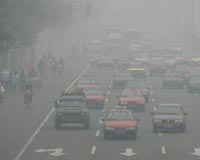 |
Washington DC (SPX) Jan 11, 2011 The so-called "superstreet" traffic design results in significantly faster travel times, and leads to a drastic reduction in automobile collisions and injuries, according to North Carolina State University researchers who have conducted the largest-ever study of superstreets and their impacts. Superstreets are surface roads, not freeways. It is defined as a thoroughfare where the left-hand turns from side streets are re-routed, as is traffic from side streets that needs to cross the thoroughfare. In both instances, drivers are first required to make a right turn and then make a U-turn around a broad median. While this may seem time-consuming, the study shows that it actually results in a significant time savings since drivers are not stuck waiting to make left-hand turns or for traffic from cross-streets to go across the thoroughfare. "The study shows a 20 percent overall reduction in travel time compared to similar intersections that use conventional traffic designs," says Dr. Joe Hummer, professor of civil, construction and environmental engineering at NC State and one of the researchers who conducted the study. "We also found that superstreet intersections experience an average of 46 percent fewer reported automobile collisions - and 63 percent fewer collisions that result in personal injury." The researchers assessed travel time at superstreet intersections as the amount of time it takes a vehicle to pass through an intersection from the moment it reaches the intersection - whether traveling left, right or straight ahead. The travel-time data were collected from three superstreets located in eastern and central North Carolina, all of which have traffic signals. The superstreet collision data were collected from 13 superstreets located across North Carolina, none of which have traffic signals. The superstreet concept has been around for over 20 years, but little research had been done to assess its effectiveness under real-world conditions. The NC State study is the largest analysis ever performed of the impact of superstreets in real traffic conditions. A paper on the travel time research is being presented Jan. 24 at the Transportation Research Board Annual Meeting in Washington, D.C. The paper is co-authored by Hummer, former NC State graduate students Rebecca Haley and Sarah Ott, and three researchers from NC State's Institute for Transportation Research and Education: Robert Foyle, associate director; Christopher Cunningham, senior research associate; and Bastian Schroeder, research associate. The collision research was part of an overarching report of the study submitted to the North Carolina Department of Transportation (NCDOT) last month, and is the subject of a forthcoming paper. The study was funded by NCDOT. The abstract of the travel time paper follows. "Operational Effects of Signalized Superstreets in North Carolina" Rebecca L. Haley, Sarah E. Ott, Joseph E. Hummer, Robert S. Foyle, Christopher M. Cunningham, Bastian J. Schroeder, North Carolina State University.
Share This Article With Planet Earth
Related Links North Carolina State University Car Technology at SpaceMart.com
 Beijing car plates oversubscribed by 10 times
Beijing car plates oversubscribed by 10 timesBeijing (AFP) Jan 9, 2011 Over 215,000 people applied for car licences in Beijing this month, but only 20,000 will be issued as the capital seeks to curb its massive traffic jams, state press said Sunday. Under a new system aimed at controlling the number of cars on Beijing streets that began this year, applicants must apply in the first eight days of the month for the 20,000 available plates issued monthly. Acco ... read more |
|
| The content herein, unless otherwise known to be public domain, are Copyright 1995-2010 - SpaceDaily. AFP and UPI Wire Stories are copyright Agence France-Presse and United Press International. ESA Portal Reports are copyright European Space Agency. All NASA sourced material is public domain. Additional copyrights may apply in whole or part to other bona fide parties. Advertising does not imply endorsement,agreement or approval of any opinions, statements or information provided by SpaceDaily on any Web page published or hosted by SpaceDaily. Privacy Statement |